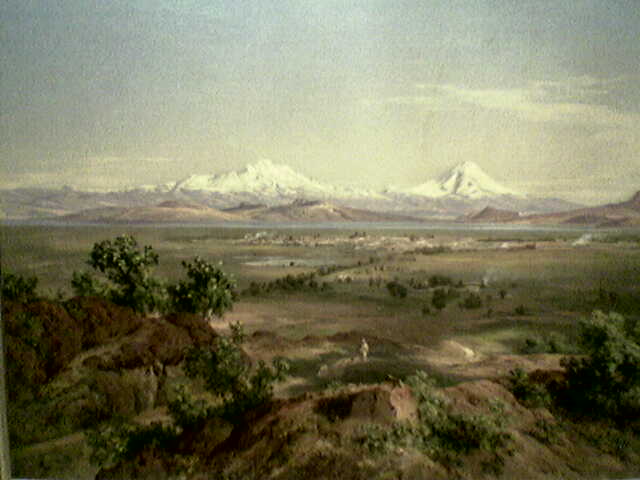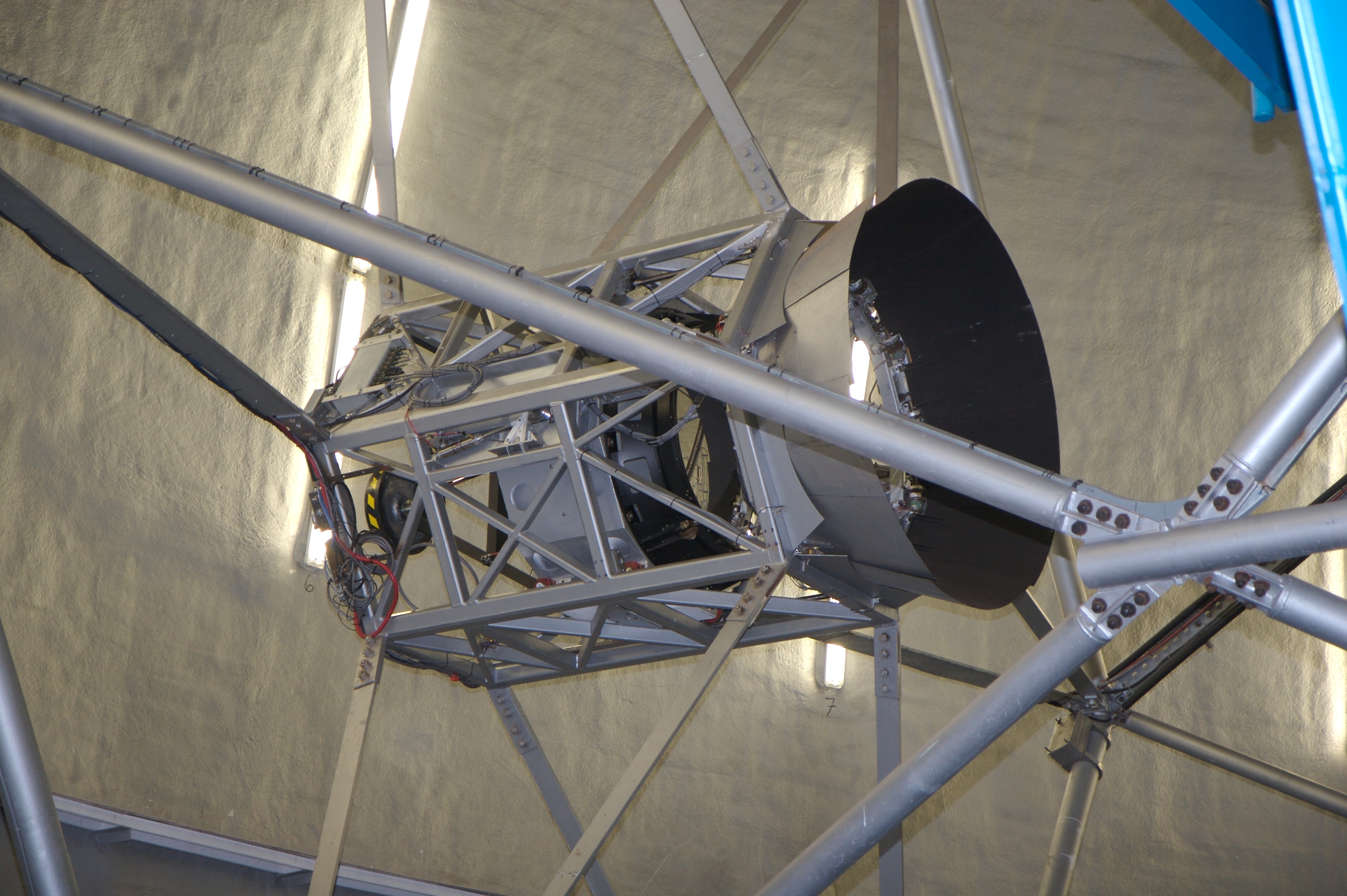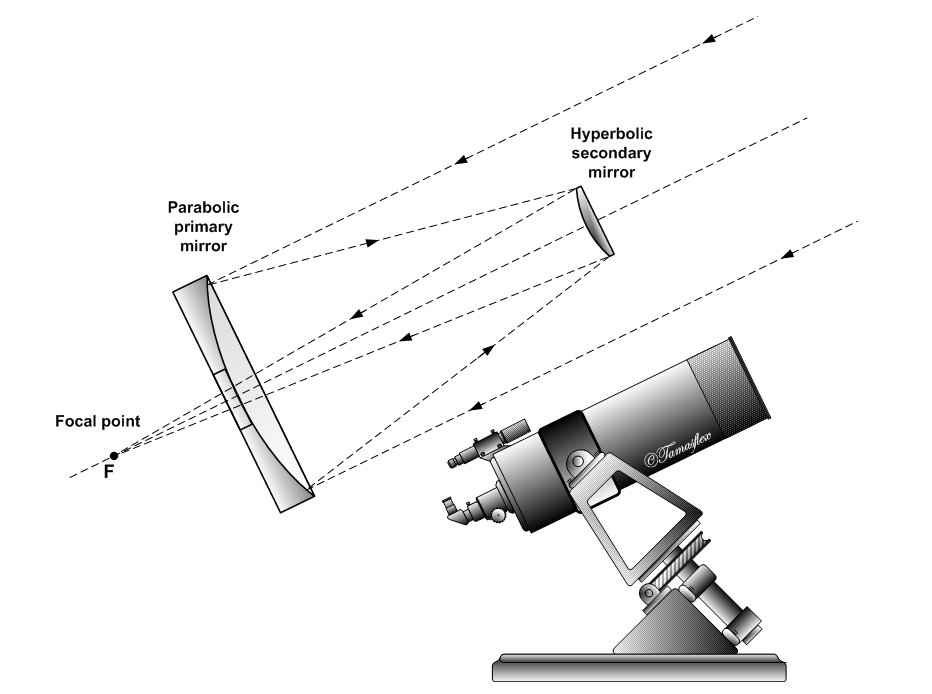|
Tonantzintla Observatory
Tonantzintla Observatory ( es, Observatorio de Tonantzintla, link=no) is an astronomical observatory located in the municipality of San Andrés Cholula in the Mexican state of Puebla. It consists of two adjacent facilities: the National Astrophysical Observatory of Tonantzintla ( es, Observatorio Astrofísico Nacional de Tonantzintla, link=no - OANTON), operated by the National Institute of Astrophysics, Optics and Electronics (INAOE), and the National Astronomical Observatory - Tonantzintla ( es, Observatorio Astronómico Nacional - Tonantzintla, link=no—OAN - Tonantzintla), operated by the National Autonomous University of Mexico (UNAM). OANTON is located on the INAOE campus, which includes numerous other buildings. OAN - Tonantzintla is located immediately to the east on mostly unused property. The observatory is located west of Puebla and east of Popocatépetl, eruptions of which sometimes interfere with observing. National Astrophysical Observatory of Tonantzintla O ... [...More Info...] [...Related Items...] OR: [Wikipedia] [Google] [Baidu] |
National Institute Of Astrophysics, Optics And Electronics
The National Institute of Astrophysics, Optics and Electronics (in Spanish: ''Instituto Nacional de Astrofísica, Óptica y Electrónica, INAOE'') is a Mexican science research institute located in Tonantzintla, Puebla. Founded by presidential decree on November 12, 1971, it has over 100 researchers in Astrophysics, Optics, Electronics and Computing Science, with postgraduate programs in these areas. INAOE is one of 30 public research centers sponsored by the National Council of Science and Technology of Mexico (''CONACyT''). The Institute, in partnership with the University of Massachusetts Amherst, developed the Large Millimeter Telescope / Gran Telescopio Milimétrico on the Puebla-Veracruz Veracruz (), formally Veracruz de Ignacio de la Llave (), officially the Free and Sovereign State of Veracruz de Ignacio de la Llave ( es, Estado Libre y Soberano de Veracruz de Ignacio de la Llave), is one of the 31 states which, along with Me ... border. The asteroid 14674 INAOE w ... [...More Info...] [...Related Items...] OR: [Wikipedia] [Google] [Baidu] |
Valley Of Mexico
The Valley of Mexico ( es, Valle de México) is a highlands plateau in central Mexico roughly coterminous with present-day Mexico City and the eastern half of the State of Mexico. Surrounded by mountains and volcanoes, the Valley of Mexico was a centre for several pre-Columbian civilizations, including Teotihuacan, the Toltec, and the Aztec. The ancient Aztec term ('Land Between the Waters') and the phrase Basin of Mexico are both used at times to refer to the Valley of Mexico. The Basin of Mexico became a well known site that epitomized the scene of early Classic Mesoamerican cultural development as well. The Valley of Mexico is located in the Trans-Mexican Volcanic Belt. The valley contains most of the Mexico City Metropolitan Area, as well as parts of the State of Mexico, Hidalgo, Tlaxcala, and Puebla. The Basin of Mexico covers approximately in the NNE-SSW direction with length to width dimensions of approximately to The Valley of Mexico can be subdivided into f ... [...More Info...] [...Related Items...] OR: [Wikipedia] [Google] [Baidu] |
Astrograph
An astrograph (or astrographic camera) is a telescope designed for the sole purpose of astrophotography. Astrographs are mostly used in wide-field astronomical surveys of the sky and for detection of objects such as asteroids, meteors, and comets. Improvements in photography in the middle 19th century led to designs dedicated to astrophotography, and they were also popular in the 20th century. As in other photography, chemicals were used that respond to light, recorded on a glass photographic plate or sometimes on photographic film. Many observatories of this period used an astrograph, beside instruments like the transit telescope, great refractors, and chronometers, or instruments for observing the Sun. Astrographs were often used to make surveys of the night sky, and one of the famous projects was Carte du Ciel. Discoveries using an astrograph include then-planet Pluto. Rather than looking through the telescope, it was discovered by using a blink comparator with image ... [...More Info...] [...Related Items...] OR: [Wikipedia] [Google] [Baidu] |
Carte Du Ciel
The Carte du Ciel (literally, 'Map of the Sky') and the Astrographic Catalogue (or Astrographic Chart) were two distinct but connected components of a massive international astronomical project, initiated in the late 19th century, to catalogue and map the positions of millions of stars as faint as 11th or 12th magnitude. Twenty observatories from around the world participated in exposing and measuring more than 22,000 (glass) photographic plates in an enormous observing programme extending over several decades. Despite, or because of, its vast scale, the project was only ever partially successful – the Carte du Ciel component was never completed, and for almost half a century the Astrographic Catalogue part was largely ignored. However, the appearance of the Hipparcos Catalogue in 1997 has led to an important development in the use of this historical plate material. Origins and goals A vast and unprecedented international star-mapping project was initiated in 1887 by P ... [...More Info...] [...Related Items...] OR: [Wikipedia] [Google] [Baidu] |
Mount Wilson Observatory
The Mount Wilson Observatory (MWO) is an astronomical observatory in Los Angeles County, California, United States. The MWO is located on Mount Wilson, a peak in the San Gabriel Mountains near Pasadena, northeast of Los Angeles. The observatory contains two historically important telescopes: the Hooker telescope, which was the largest aperture telescope in the world from its completion in 1917 to 1949, and the 60-inch telescope which was the largest operational telescope in the world when it was completed in 1908. It also contains the Snow solar telescope completed in 1905, the 60 foot (18 m) solar tower completed in 1908, the 150 foot (46 m) solar tower completed in 1912, and the CHARA array, built by Georgia State University, which became fully operational in 2004 and was the largest optical interferometer in the world at its completion. Due to the inversion layer that traps warm air and smog over Los Angeles, Mount Wilson has steadier air than any other location in ... [...More Info...] [...Related Items...] OR: [Wikipedia] [Google] [Baidu] |
Don Hendrix
Don O. Hendrix (1905–1961) was an American optician.Centennial History of the Carnegie Institution of Washington: Page 474 Allan Sandage, Louis Brown, Patricia Parratt Craig - 2004 "Don O. Hendrix (1905–1961) Don Hendrix was a genius with a high school ..." In 1932, American scientist, inventor, and optician Don Hendrix began developing the Schmidt Camera at the Mount Wilson Observatory in Southern California, where by 1942 he would go on to become the master optician. A genius with only a highschool education, Hendrix was a prolific inventor who by his death in 1962, in addition to his accomplishments and contributions to astronomy and optics had hundreds of patents to his name, most of which were donated to the U.S. Government. He experimented with various technologies and among many firsts was the first person to use aluminum instead of silver in the mirrors he created for the Carnegie Institute's telescopes. During the time he spent at the Carnegie Institute he worked on m ... [...More Info...] [...Related Items...] OR: [Wikipedia] [Google] [Baidu] |
Secondary Mirror
A secondary mirror (or secondary) is the second deflecting or focusing mirror element in a reflecting telescope. Light gathered by the primary mirror is directed towards a focal point typically past the location of the secondary. Secondary mirrors in the form of an optically flat ''diagonal mirror'' are used to re-direct the light path in designs such as Newtonian reflectors. They are also used to re-direct and extend the light path and modify the final image in designs such as Cassegrain reflectors. The secondary is typically suspended by X-shaped struts (sometimes called a "spider") in the path of light between the source and the primary, but can be mounted on other types of mounts or optical elements such as optical windows, or schmidt and meniscus corrector plates. Employing secondary mirrors in optical systems causes some image distortion due to the obstruction of the secondary itself, and distortion from the spider mounts, commonly seen as cross-shaped diffraction spikes ... [...More Info...] [...Related Items...] OR: [Wikipedia] [Google] [Baidu] |
Primary Mirror
A primary mirror (or primary) is the principal light-gathering surface (the objective) of a reflecting telescope. Description The primary mirror of a reflecting telescope is a spherical or parabolic shaped disks of polished reflective metal ( speculum metal up to the mid 19th century), or in later telescopes, glass or other material coated with a reflective layer. One of the first known reflecting telescopes, Newton's reflector of 1668, used a 3.3 cm polished metal primary mirror. The next major change was to use silver on glass rather than metal, in the 19th century such was with the Crossley reflector. This was changed to vacuum deposited aluminum on glass, used on the 200-inch Hale telescope. Solid primary mirrors have to sustain their own weight and not deform under gravity, which limits the maximum size for a single piece primary mirror. Segmented mirror configurations are used to get around the size limitation on single primary mirrors. For example, the Gia ... [...More Info...] [...Related Items...] OR: [Wikipedia] [Google] [Baidu] |
Cassegrain Reflector
The Cassegrain reflector is a combination of a primary concave mirror and a secondary convex mirror, often used in optical telescopes and radio antennas, the main characteristic being that the optical path folds back onto itself, relative to the optical system's primary mirror entrance aperture. This design puts the focal point at a convenient location behind the primary mirror and the convex secondary adds a telephoto effect creating a much longer focal length in a mechanically short system. In a symmetrical Cassegrain both mirrors are aligned about the optical axis, and the primary mirror usually contains a hole in the center, thus permitting the light to reach an eyepiece, a camera, or an image sensor. Alternatively, as in many radio telescopes, the final focus may be in front of the primary. In an asymmetrical Cassegrain, the mirror(s) may be tilted to avoid obscuration of the primary or to avoid the need for a hole in the primary mirror (or both). The classic Cassegrai ... [...More Info...] [...Related Items...] OR: [Wikipedia] [Google] [Baidu] |
Figuring
Figuring is the process of final polishing of an optical surface to remove imperfections or modify the surface curvature to achieve the shape required for a given application. Types An example of figuring is that used in reflecting telescope primary mirrors in a process of converting the smooth spherical mirror produced by earlier stages into the aspherical or parabolic shapes needed to form the correct image. It is done by applying different polishing stroke lengths with different sized and shaped tools. Manual figuring is a very laborious process, since the heat produced by polishing has to be allowed to dissipate before the shape of the mirror can be measured again, and the places for later polishing selected. Testing of the figure is usually done by a Foucault knife-edge test or Ronchi test in amateur telescope making and with very sophisticated null testers on research telescope optics. For large mirrors, ion figuring is often used, in which a beam of neutral atoms i ... [...More Info...] [...Related Items...] OR: [Wikipedia] [Google] [Baidu] |
Sierra De San Pedro Mártir
Sierra de San Pedro Mártir ( Kiliwa: ʔxaal haq, en, mountains of Saint Peter the Martyr) is a mountain range located within southern Ensenada Municipality and southern Baja California state, of northwestern Mexico. It is a major mountain range in the long Peninsular Ranges System, that extends from Southern California down the Baja California Peninsula into Baja California Sur state. Geography The range's highest peak is Picacho del Diablo at in elevation. Also known as ''Cerro de la Encantada'' (Enchanted Mountain) and ''Picacho la Providencia'' (Providence Peak), it is the highest point in Baja California state and of the entire Baja California Peninsula. The range is a drainage divide that demarcates the drainages flowing west into the Pacific Ocean or east into the Gulf of California for this section of the Baja California Peninsula. Snow is usually present at the highest elevations in the winter. The Sierra de Juárez are on the north, and Sierra de San Francisco a ... [...More Info...] [...Related Items...] OR: [Wikipedia] [Google] [Baidu] |







